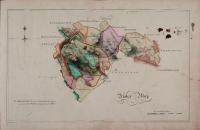Ireland in the ‘age of improvement’
Published in 18th–19th - Century History, Features, Issue 2(March/April 2011), Volume 19
Knockdrin estate map. The large field units suggest consolidation—the amalgamation of multiple smallholdings into much larger field units—and an emerging rural economy where bullocks increasingly replaced small tenants. (National Library of Ireland)
Thomas Kearney’s 1817 map of the Levinge estate in Knockdrin, Co. Westmeath, is a particularly fine example of an early nineteenth-century survey of an improving landlord’s estate during the twilight era of landlord paternalism in Ireland. So-called ‘improving landlords’ were committed to implementing the latest scientific developments to modernise their estates in terms of animal husbandry, land reclamation, the landscaping of their demesnes and the cultivation of timber plantations. The Levinge estate is typical of such aspirations, and the aesthetic quality of Kearney’s map is indicative of the landowner’s harmonious vision for his estate, with a carefully landscaped demesne featuring two watercourses and a timber plantation complete with manicured tree lines and an appealing lake vista. The most notable feature of Kearney’s survey, however, concerns what one Irish historian has termed ‘the presence of absence in the Irish landscape’ to describe the gradual disappearance of the rural poor from the physical landscape during the nineteenth century. The management of a well-run, economically viable estate was complicated by the presence of a significant body of tenantry, usually poverty-stricken and innately prone to bouts of violent disaffection. The central contradiction for improving landlords centred around the fundamental paradox between their self-perceived role as pivots of a harmonious, progressive, rural idyll—suggested here by Kearney’s use of soft pastel colours—and the human reality of the horrors of widespread evictions, often the precursor to the creation of a ‘modern estate’.
The modernisation of the rural economy from the latter half of the eighteenth century onwards undermined the traditional paternalism of the Irish gentry and exacerbated the enduring economic crisis faced by the rural poor. As landowners’ increasing preference for pastoral farming structurally transformed rural society, the traditional economic bonds between landowners and the poor were eroded as the landless faced a steady decline in the demand for their labour and a gradual rise in the cost of their rent. Field consolidation—the amalgamation of multiple smallholdings into much larger field units—was indicative of an emerging rural economy where bullocks increasingly replaced small tenants, and the large field units on the Knockdrin survey are typical of grassland ‘ranches’.
The mounting anxiety that rural society was gradually being overwhelmed by the escalating destitution of an increasingly desperate rural population became a growing source of alarm during the early decades of the nineteenth century, provoking a protracted debate regarding the human cost and the economic necessity of agricultural modernisation. The dread of an emerging social crisis posed a range of moral dilemmas for landowners and provoked a re-examination of the relationship between the duties of Christian charity and the necessities of political economy. A government committee set up to investigate the state of the poor in 1830 concluded that by the early decades of the eighteenth century rural Ireland had entered a state of transition: ‘A change then began to take place in the system of managing lands . . . an anxiety began to be felt by the proprietors to improve the value of their estates and a general impression was produced in the minds of all persons that a pauper population spread over the country . . .’.
Many contemporary observers continued to blame the perceived lethargy of the poor for the inherent backwardness of the rural economy, claiming that the fundamental lack of industry amongst the labouring classes innately retarded economic progress. In response to widespread distress in the west in the summer of 1822, one western newspaper concluded that the potato itself was to blame for the prevalence of poverty, as ‘the ease of the potatoes, both in sowing, reaping and preparation left the peasant in too much leisure to contract bad habits and have evil communications, or in idleness they will sit roasting their legs at the fire during a large portion of the day and many of them are kept thus in a state of barbarity’. A government committee set up in 1825, however, fundamentally contradicted the notion that the poor were chiefly responsible for the backwardness of the rural economy, noting that ‘want of demand for labour necessarily ensures very severe distress among the labouring classes. This, combined with the consequences of an altered system of managing land, is stated to produce misery and suffering which no language can possibly describe and which it is necessary to witness in order fully to estimate.’
The decision of the government in 1830 to recommend the establishment of a system of Poor Law relief adapted from the English and Scottish model fundamentally exposed the paternal pretensions of large landowners and highlighted the failure of the emerging rural economy to absorb the impoverished masses. For landowners, distress amongst the poor remained a regrettable but necessary by-product of modernisation, and the role of charity lay merely in tempering the excessive zeal of improving landlords, who continued to view farm consolidation and tenant clearances as both necessary and desirable. As the government noted, ‘the risk to be apprehended is not that the proprietors of land should be insensible to these considerations, but that they should, in some cases, proceed with too much rapidity’. Noting ‘the evils of a transition state’, the government committee concluded that ‘these present difficulties in Ireland appear to be incidental to a transition from one system to another’.
Thomas Kearney’s survey of the Levinge estate can be downloaded from the National Library’s flickr site, at www.flickr.com/photos/nlireland, along with a range of other documents featured in this series. Readers can keep track of all events at the Library on the Library’s facebook and twitter sites. HI
















